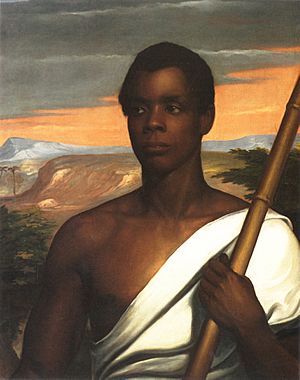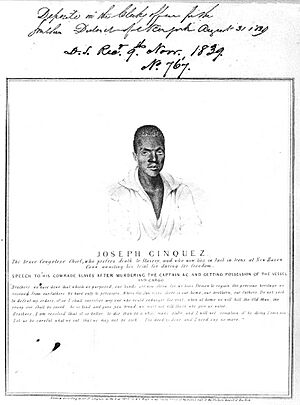Joseph Cinqué facts for kids
Quick facts for kids
Sengbe Pieh
|
|
|---|---|

Cinqué in 1840
|
|
| Born | c. 1814 |
| Died | c.1879 (aged around 65) British Sierra Leone
|
| Other names | Joseph Cinque |
| Known for | Amistad case |
| Signature | |
Sengbe Pieh (c.1814 – c.1879), also known as Joseph Cinqué, was a man from West Africa. He belonged to the Mende people. In July 1839, he led a brave rebellion of many Africans on a Spanish slave ship called La Amistad.
After the ship was captured by the United States Revenue Cutter Service, Cinqué and the other Africans faced a trial. This famous case, known as United States v. The Amistad, went all the way to the U.S. Supreme Court. The court decided that Cinqué and his friends had every right to defend themselves. They were being illegally forced into slavery. The court ordered them to be set free. The US government did not help them return home. However, a Black group called the United Missionary Society raised money. This helped thirty-five survivors return to Sierra Leone in 1842.
Contents
Early Life and Enslavement
Cinqué was born around 1814 in the area we now call Sierra Leone. We don't know his exact birthday. He was a rice farmer and had a wife and three children. Sadly, he was sold into slavery to pay off a debt.
In 1839, he was bought by a Vai king named Siaka. Then, he was sold again to Pedro Blanco, a Spanish slave trader. Cinqué was put on a Portuguese slave ship called Tecora. This was against the rules and treaties that banned the international slave trade. Cinqué was taken to Havana, Cuba. There, he and 110 other people were sold to two Spaniards, José Ruiz and Pedro Montez.
The Amistad Rebellion
The Spaniards planned to move the captives on a small ship called the Amistad. They wanted to sell them as slaves at different ports in Cuba. These people would then be forced to work on sugar plantations.
On June 30, Cinqué led a rebellion. The Africans fought back to gain their freedom. They took control of the ship. Two of the Spanish crew members died during the struggle. Two sailors managed to escape. The Africans took Ruiz and Montez, the men who bought them, as prisoners. They demanded that the Spaniards sail the ship back to Sierra Leone.
Instead, at night, Ruiz and Montez secretly steered the ship in the wrong direction. They sailed towards the Americas. They hoped another Spanish ship would find them and help them regain control. The Amistad sailed an unpredictable path between the US coast and Africa. After about two months, the Amistad reached waters near Long Island, New York.
The Trial for Freedom
Members of the USS Washington boarded the Amistad. They learned what had happened from the Spaniards. The Africans were then accused of taking over the ship and other serious actions. The ship and the Mende people were taken to New Haven, Connecticut. There, they waited for their trial.
The two Spaniards claimed that the Africans were born in Cuba. They said the Africans were already slaves when they bought them. This would have made them legal property. But interpreters who spoke the Mende language were found. This allowed the Africans to tell their true story to their lawyers and the court. Cinqué became the main spokesperson for the group.
The local and circuit courts ruled in favor of the Africans. But the Spanish parties, including their government, appealed the case. It went to the highest court in the land, the Supreme Court of the United States.
In March 1841, the Supreme Court made a very important decision. They ruled that the Africans had rebelled to get their freedom back. They had been kidnapped and sold illegally. Former U.S. President John Quincy Adams and Roger Sherman Baldwin played a key role in defending the Africans. The court ordered that the Africans be freed. They could return to Africa if they wished. This decision was made even though President Martin Van Buren was worried. He feared it would harm relations with Spain and affect slavery in the US.
Return to Africa
Cinqué and the other Mende people finally reached their homeland in 1842. When Cinqué arrived in Sierra Leone, he found that there was a civil war happening. He and his group stayed in touch with a local mission for some time. But Cinqué later left to trade along the coast.
Not much is known about his later life. There were many rumors about what happened to him. Some people said he moved to Jamaica. Others believed he became a merchant or a chief. Some even claimed he might have traded in slaves himself.
However, historians like Howard Jones and Joseph Yannielli have looked into these claims. They say that while some Africans from the Amistad might have been involved in the slave trade later, there is no real proof that Cinqué was. It seems unlikely given the lack of evidence.
Samuel Pieh, a great-great-grandson of Sengbe Pieh, was a language coach for the 1997 Amistad movie. He stated that Cinqué became an important person in Sierra Leone. He also helped to spread Christianity in the country.
In Popular Culture
- The 1997 film Amistad tells the story of the rebellion and trial. Cinqué was played by the actor Djimon Hounsou.
- A statue of Cinqué stands outside City Hall in New Haven. It honors Cinqué and the Amistad events.
- A golden sculpture of Cinqué is located outside the Old State House in Hartford. This is where the first part of the Amistad trial took place.
- The likeness of Sengbe Pieh appears on Sierra Leone's 5000 leone banknote.
- American composer Anthony Davis wrote an opera called Amistad in 1997. It was based on these events.
- J. Ivy mentions Cinqué in his part on the Kanye West song "Never Let Me Down."
See also
- Amistad (case), about the rebellion and the Supreme Court case.
- Amistad (film), a movie about the court case.
- Amistad (ship replica), a copy of the ship.
- Amistad Research Center at Tulane University, New Orleans
- List of slaves
 In Spanish: Joseph Cinqué para niños
In Spanish: Joseph Cinqué para niños


